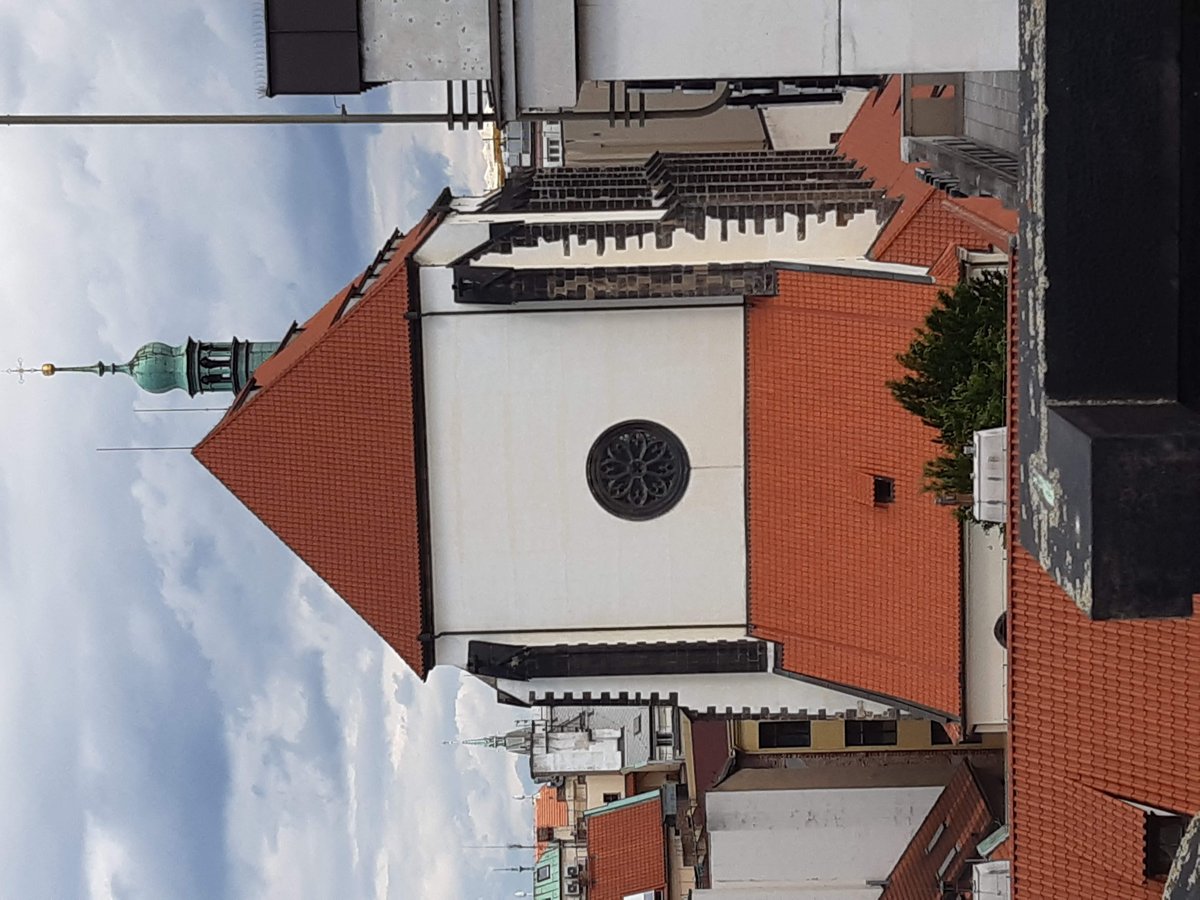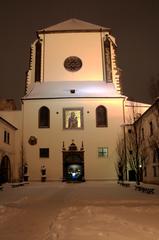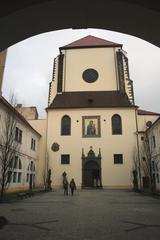
Church of Our Lady of the Snow: Visiting Hours, Tickets, and Historical Significance in Prague
Date: 14/06/2025
Introduction
Nestled in the heart of Prague’s New Town, the Church of Our Lady of the Snow (Kostel Panny Marie Sněžné) stands as a testament to the city’s medieval ambitions and Baroque artistry. Founded by Emperor Charles IV in 1347, the church was originally intended as a monumental Gothic basilica to rival St. Vitus Cathedral in scale and significance. Although construction was interrupted by the Hussite Wars and only the choir was completed, the church boasts the tallest Gothic vault in Prague, creating a dramatic and awe-inspiring space. Over the centuries, it has evolved from a medieval coronation church to a Baroque sanctuary under Franciscan care, serving today as both an active parish and a vibrant cultural center.
This detailed guide explores the church’s fascinating history, architectural highlights, religious and cultural significance, and provides practical visitor information including hours, tickets, accessibility, and nearby attractions. Whether you are a history enthusiast, architecture lover, or traveler seeking spiritual reflection, the Church of Our Lady of the Snow is a must-see destination in Prague.
For further reading and planning, visit A View On Cities, Prague.eu, and TripHobo.
Table of Contents
- Foundation and Medieval Origins
- Architectural Ambitions and Incomplete Construction
- Turbulence of the Hussite Wars and Decline
- Baroque Revival and Franciscan Stewardship
- Artistic Heritage and Notable Features
- Religious and Cultural Significance
- The Franciscan Garden and Modern Role
- Visiting Hours, Tickets, and Visitor Information
- Travel Tips and Accessibility
- Nearby Attractions
- Frequently Asked Questions (FAQ)
- Conclusion
Foundation and Medieval Origins
The Church of Our Lady of the Snow was conceived by Emperor Charles IV as a grand Gothic basilica immediately after his coronation as King of Bohemia in 1347. He envisioned the church as a central place of worship for the New Town and as a rival to the Cathedral of St. Vitus, underscoring Prague’s growing spiritual and political importance (A View On Cities; Prague.cz). The dedication to “Our Lady of the Snow” is inspired by a Roman legend associated with the Basilica di Santa Maria Maggiore, where a miraculous August snowfall prompted the church’s construction—a tradition commemorated annually on August 5 (Prague.net).
Architectural Ambitions and Incomplete Construction
The original design called for a three-aisled Gothic basilica of around 110 meters in length, making it the second-largest church in Prague after St. Vitus Cathedral (A View On Cities; Lonely Planet). The Carmelite Order was entrusted with the project, and the workshop of Peter Parler, architect of St. Vitus, likely contributed to its construction (Prague.fm).
However, only the choir and part of the bell tower were completed before construction was halted by the Hussite Wars. The choir’s vault, at 34 meters, remains Prague’s tallest, reflecting the church’s intended grandeur (Prague.net). The nave was never finished, resulting in a unique structure with a soaring vertical emphasis but a truncated footprint.
Turbulence of the Hussite Wars and Decline
In the early 15th century, the Hussite Wars brought turmoil. The church was seized by Hussite forces, with the reformer Jan Želivský famously preaching there before his execution (Lonely Planet). Construction ceased, the Carmelites abandoned the site, and the building suffered structural damage and deterioration. By the late 16th century, only three walls remained intact (A View On Cities).
Baroque Revival and Franciscan Stewardship
Restoration began in the early 17th century when Emperor Rudolf II granted the church to the Discalced Franciscans. They rebuilt the vault and roof, incorporating Renaissance and Baroque elements, and added a new façade with a choir loft (Prague.fm). The spectacular Baroque high altar, constructed from 1649 to 1651, is the tallest in Prague at 29 meters, adorned with statues, paintings, and gilded decorations (A View On Cities). Works by artists like Antonín Stevens and Wenzel Lorenz Reiner further enrich the interior (Prague.cz).
Artistic Heritage and Notable Features
Despite its incomplete construction, the church is a treasure trove of Gothic and Baroque art. Notable features include:
- The monumental Baroque altar, a masterpiece of sculpture and painting.
- 17th-century sculptures and altarpieces by renowned artists.
- A Gothic portal with figures of the Virgin Mary, Charles IV, and his wife Blanche.
- Renaissance net vaulting and a Gothic baptismal font from 1459.
- Stained glass windows depicting Marian and Franciscan themes (Prague.fm; A View On Cities).
Important Czech figures are interred here, adding to the church’s national significance (Prague.net).
Religious and Cultural Significance
The church’s original intent as a coronation site and its association with Jan Želivský link it to pivotal moments in Czech religious history (Prague.cz). The martyrdom of Franciscan friars in 1611, commemorated within, is a key episode for the Franciscan Order (Wikipedia). Today, the church continues to serve as an active parish and a center for spiritual life and cultural events.
The Franciscan Garden and Modern Role
Adjacent to the church, the Franciscan Garden offers a peaceful oasis amid the city. Redesigned in the 17th century and opened to the public in 1950, it provides the best vantage point for viewing the church’s exterior, with sculptures, fountains, and flower beds (A View On Cities). The church remains a hub for worship, concerts, and exhibitions, embodying Prague’s enduring spiritual and artistic vitality (Prague.fm).
Visiting Hours, Tickets, and Visitor Information
- Visiting Hours: Usually open Monday–Saturday, 9:00 AM–5:00 PM; Sunday, 12:00 PM–5:00 PM (hours may vary on holidays—check the official website).
- Tickets: Free entry; donations appreciated. Guided tours may have a nominal fee.
- Guided Tours: Available in multiple languages; advance booking recommended, especially for groups.
- Accessibility: Wheelchair accessible, with ramps and accessible restrooms.
- Photography: Permitted without flash; please respect ongoing services.
- Special Events: Seasonal concerts and exhibitions are held throughout the year; check local listings for schedules.
- Virtual Tours: Online resources and virtual tours are available for remote visitors.
Travel Tips and Accessibility
- Public Transport: Conveniently located near Můstek metro station (Lines A and B) and tram stops at Václavské náměstí or Lazarská.
- Dress Code: Modest attire requested; shoulders and knees covered.
- Facilities: No public restrooms inside, but nearby cafes and public facilities are available.
- Safety: The area is central and safe; watch belongings during busy events.
(Prague’s Best Places; View from Prague)
Nearby Attractions
- Wenceslas Square: Vibrant city boulevard with shops, dining, and landmarks.
- Old Town Square: Home to the Astronomical Clock and Týn Church.
- Franciscan Garden: Serene retreat adjacent to the church.
- Svetozor Shopping Passage: Popular for cafes and local treats.
(View from Prague; Prague’s Best Places)
Frequently Asked Questions (FAQ)
Q: What are the typical visiting hours?
A: Usually 9:00 AM–5:00 PM (Monday–Saturday), 12:00 PM–5:00 PM (Sunday). Hours may vary on holidays.
Q: Is there an entrance fee?
A: No, admission is free. Donations are appreciated.
Q: Are guided tours available?
A: Yes, in multiple languages; book in advance for groups or special interests.
Q: Is the church accessible to visitors with disabilities?
A: Yes, the main entrance and major areas are wheelchair accessible.
Q: Can I attend Mass or religious services?
A: Yes, regular services are open to the public. Check posted schedules.
Q: Can I take photographs inside?
A: Yes, but no flash allowed. Follow posted guidelines and respect religious ceremonies.
Q: Are there special events to look out for?
A: Yes, including concerts, exhibitions, and the popular Night of Churches in June.
Conclusion
The Church of Our Lady of the Snow is a cornerstone of Prague’s historical, artistic, and spiritual landscape. Its soaring Gothic vaults, remarkable Baroque altar, and tranquil gardens offer a unique window into the city’s layered past and present. Whether you are drawn by history, architecture, or the peaceful atmosphere, this church promises an unforgettable experience. Plan your visit to coincide with special events or simply enjoy a quiet hour in the Franciscan Garden.
For updated visiting hours, event listings, and insider tips, consult Prague.cz, GPSmyCity, and Evendo. Enhance your visit by downloading the Audiala app for immersive audio tours and real-time updates.
























































































































































































